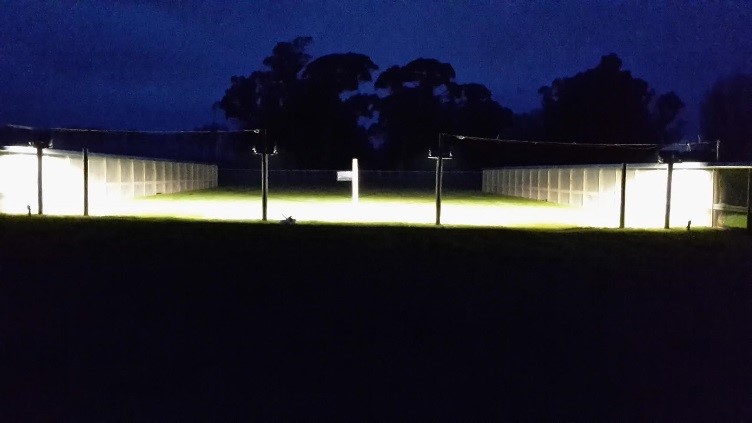Urban and rural landscapes have the potential to be protected from invading predator species through the use of fences. For predator fenced regions to be successful in mainland New Zealand, vehicle and civilian traffic needs to flow unrestricted.
Roadways and footpaths create openings in fences - points of weakness where predators can access protected regions. If permanent or ‘rolling front’ fences are going to assist in achieving New Zealand’s Predator Free 2050 goals, then we must find ways of defending these openings.
In 2016, ZIP began investigating various deterrents to protect a simulated opening in a predator fence, starting with the potential of using lighting as a deterrent.
What we did initially and the results
With the aid of lighting engineers, powerful LED light towers were erected in the centre of a 20m wide corridor, located inside the 2 hectare predator enclosure at Lincoln. These light fittings were capable of directing light downward, forming a definitive line of light. Initially, trials were conducted with all light towers turned on, highly illuminating the 20m wide strip across the whole corridor.
Five metres within the lit zone, on both sides of the corridor, a trap box containing two DOC200 traps (with kill bars deactivated), offered shelter for the rats from the light. Attempts to cross the lit zone were recorded on cameras.
Rats that passed through the lit zone were caught on the other side in live capture cage traps.
Ten rats were individually released, after dark, inside the predator enclosure, on the entrance side of the corridor, and allowed to move around on their own for three nights. For five of the rats, all of the light towers were turned on; for the other five rats, the light towers were turned off.
Night time images of the 2ha light deterrent set up. Full illumination of initial trials on the left, and revised trial design including a 5m darkness corridor on the right.
All ten rats passed through the corridor – i.e. whether the light towers were turned on or off. This indicated that artificial illumination on its own was not a strong deterrent.
Notably, all ten rats passed through the trap boxes on their way through the corridor.
What we did next and the results
The initial results led us to test whether we could ‘channel’ invading rats into the trap boxes though the use of lighting. We therefore modified the lighting to create a 5m dark zone and a 15m lit zone across the corridor. Once again, we filmed the animals’ behaviour as they approached and crossed the corridor.
This time we trialled 20 rats. All but two of the rats entered the corridor and passed through to the protected area.
Each rat crossed the corridor directly from the side where it entered it - i.e. from either the lit zone or the dark zone. In other words, none of the rats that first encountered the lit zone were initially deterred and later crossed using the dark zone of the corridor.
Only 1 out of the 8 rats that first encountered the lit zone crossed it immediately. Camera footage showed a high degree of hesitation among the other seven rats that encountered the lit zone before they crossed it. Nonetheless, all of these rats eventually crossed the lit zone on the same or a subsequent evening.
In comparison, 7 of 10 rats that first encountered the dark zone crossed it immediately, i.e. without any hesitation.
17 of the 18 rats passed through the trap boxes in the course of making their way through the corridor. Rats that crossed through the lit zone showed much less hesitation entering the trap box compared to rats that crossed through the dark zone – i.e. rats that crossed the lit zone entered the trap boxes faster than rats that crossed through the dark zone.
The one rat that immediately crossed the lit zone also did not pass through the trap box. To us, that rat represents a ’perfect’ invader - which we need to learn how to deter or intercept!
What does this mean for the future?
As a prey species, rats are forced to continuously make decisions that balance risk and reward. The results of this trial suggest that illumination alone is not enough of a risk (or “punch”) to deter rats from invading through a large opening in a predator fence.
We also learned that artificial illumination alone is not enough of a deterrent to steer rats passing through an opening in a predator fence towards a darkened area.
While light did not appear to steer a rat towards a darkened area, rats were less likely to linger in a lit zone – and as a result entered the trap boxes more quickly than the rats passing through a dark zone. For a nocturnal animal, such as a rat, light represents an increased risk of predation, so we are not surprised that rats crossing the lit zone sought shelter in the trap boxes more quickly that the rats crossing the dark zone.
Future work could investigate (i) whether a more direct form of illumination (e.g. at ground level, into the eyes of the invading rats) could be a more effective deterrent than the top-down lit zone used in this trial, and (ii) the potential of artificial illumination to slow down invading rats to increase the effectiveness of other deterrents.
Finally, this trial also confirmed the common knowledge that rats like to run along the edges of structures, because the solid side (even of a predator fence) protects them from that side, helps them navigate by whisker touch and familiarity, and often indicates nearby shelter (e.g. a trap box).
Rat seeking shelter within a trap box, located 5m inside the illuminated corridor of the ZIP 2ha predator proof enclosure at Lincoln
Want to learn more?
Check out the technical report.





